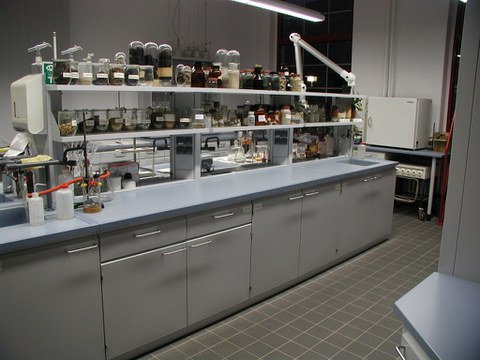Energieverfahrenstechnisches Labor
| Leiterin: | Dr. rer. nat. Kathrin Gebauer |
| Laborantin: | Romy Fischer |
| Chemikant: | Frank Reuner |
Walther-Pauer-Bau, Zi. 109/112/113
George-Bähr-Str. 3b
01069 Dresden
Tel.: +49 (0)351-463-33663
E-Mail: Kathrin.Gebauer@tu-dresden.de
Die Professur für Energieverfahrenstechnik verfügt über ein Labor sowie über ein Technikum mit verschiedenen Versuchsanlagen.
Nach DIN oder DIN-conform werden grundlegende Untersuchungen zur Brennstoffanalyse sowie dem Asche- und Abbrandverhalten durchgeführt. Eine Brennstoffanalyse umfasst u. a. die Kurzanalyse, die Elementaranalyse, die Bestimmung des Brenn- und Heizwertes sowie die Siebanalyse. Bei den Asche- und Schlackeanalysen werden das Schmelzverhalten und die chemische Zusammensetzung sowohl von Brennstoffaschen als auch von Ansatzproben, z. B. aus Verbrennungsversuchen, untersucht. Darüber hinaus werden kinetische Daten zum Zünd- und Abbrandverhalten von Brennstoffen im Zündofen und Batch-Reaktor ermittelt.
- Probenteiler PT 100 (Retsch GmbH) & Riffelteiler
- Trockenschränke (verschiedene Größen)
- verschiedene Mühlen (Retsch GmbH): Schneidmühle SM 300, Ultrazentrifugalmühle ZM 100 & ZM 200, Kugelmühle PM 100, Kugelmühle XRD-Mill McCrone
- sonstige Mühlen: Scheibenschwingmühle, Kohlemühle
- Feuchteanalysatoren (Mettler Toledo):
- Halogentrockner HR 73
- Halogentrockner HB 43
- Infrarottrockner LP 16 - Laborwaagen (Mettler Toledo):
- Analysenwaage XP205DR
- Präzisionswaage XS4002SDR - Laborwaagen (Sartorius):
- Elektronische Mikrowaage M2P
- Analysenwaage AC210S
- Analysenwaage BP61 - Laboröfen (Muffelöfen) (Nabertherm):
- Tmax = 1.100 °C
- Tmax = 1.100 °C, incl Inertgasanschluss - Partikelanalyse:
- Schwing-Siebmaschine AS 200 control (Retsch GmbH) incl. verschiedener Analysensiebe (32 µm bis 50 mm) - Brennwertanalyse:
- Kalorimeter C 6000 (IKA-Werke)
- Kalorimeter C200 (IKA-Werke) - Elementaranalyse:
- Vario El (Elementar Hanau) für die Kohlenstoff-, Wasserstoff- und Stickstoffbestimmung
- Eltra CS 580 (Eltra GmbH Neuss) für die Schwefelbestimmung - Röntgenspektrometer Epsilon 3 (PANalytical)
- Röntgendiffraktometer D8 Advance ECO (Bruker)
- Thermowaage (TGA/DSC) (Mettler Toledo)
- Thermowaage (DTA) Netzsch
- FTIR-Gasanalysator CX-4000 (Ansyco)
- Multifunktionsmessgeräte für pH-Wert und Leitfähigkeit mit Labormesssonden (verschiedene Hersteller)
- Kontaktwinkelmessgerät
- Photometer
- Gaschromatograph
- Ionenchromatograph ICS 1000 (DIONEX GmbH) mit Suppressortechnik für Anionen
- Ionenchromatograph ICS 1100 (DIONEX GmbH) mit Suppressortechnik für Kationen
- Titrator (Mettler)
- Karl Fisher-Titrator
- Hochtemperatur-Kammerofen (Thermconcept), Tmax = 1.750 °C
- Mikrowellenauschlusssystem TOPwave (Analytik Jena)
- Rotationsverdampfer incl. Pumpenstand (IKA/Vacuubrand)
- Sorptomatic 1990 (Porotec)
- Pycnomatic ATC (Porotec)
- Verschiedene Ultraschallbäder
- Thermostate
- Magnetrührwerke
- Heizplatten
- Zentrifuge
Kleintechnische Versuchsanlagen:
Das energieverfahrenstechnische Labor bietet seit 2005 Schülerpraktika an. Diese wurden seit jeher gut angenommen, sodass sich über die letzten knapp zwei Jahrzehnte jedes Jahr fünf bis zehn Schülerinnen und Schüler angemeldet haben, um das Labor und die Arbeit darin kennenzulernen.
Wir empfehlen das Schülerpraktikum im Labor für Schülerinnen und Schüler ab der 9. Klasse.
Hauptaufgaben:
- allgemeine Mitarbeit im energieverfahrenstechnischen Labor
- Unterstützung bei der Probenvorbereitung
- Anwendung verschiedener chemischer und physikalischer Messmethoden
- eigenständige Brennstoff- und Wasseranalysen
Das Schülerpraktikum kann zu jedem Zeitpunkt des Jahres begonnen werden und erstreckt sich über einen Zeitraum von 1 - 2 Wochen.
Das ganze Praktikumsangebote an der TU Dresden einschließlich des EVT-Labors finden Sie hier: Praktikumsplätze für Schüler:innen — Studium — TU Dresden
Das vollumfängliche Angebot zur Studienorientierung erwartet Sie unter der Rubrik "Uni testen". Ob Praktika, Mentoring, Workshops, Girl's Day oder Probestudium, hier warten zahlreiche Informationen und Möglichkeiten, die TU Dresden, den Campus, das Studienleben und verschiedene Fachrichtungen kennenzulernen: UNI TESTEN — Studium — TU Dresden
Wir freuen uns sehr, dass wir im Schuljahr 2024/2025 acht engagierte Schülerinnen und Schüler der Klassenstufen 9 bis 11 bei uns im Labor für Energieverfahrenstechnik begrüßen durften. Die vier Mädchen und vier Jungen kamen aus verschiedenen Schulen in Dresden, Dippoldiswalde und Großenhain und brachten großes Interesse an naturwissenschaftlichen und technischen Themen mit.
Während ihres Praktikums erhielten die Jugendlichen spannende Einblicke in die Arbeit unseres Forschungslabors. Sie unterstützten bei Brennstoff- und Ascheanalysen, halfen Studierenden bei ihren Studienarbeiten und recherchierten zu neuen Analysemethoden. Neben den praktischen Tätigkeiten im Labor nahmen sie auch an Studentenpraktika im Rahmen verschiedener Lehrveranstaltungen teil, die durch die Mitarbeiter:innen des EVT-Labors betreut wurden.





